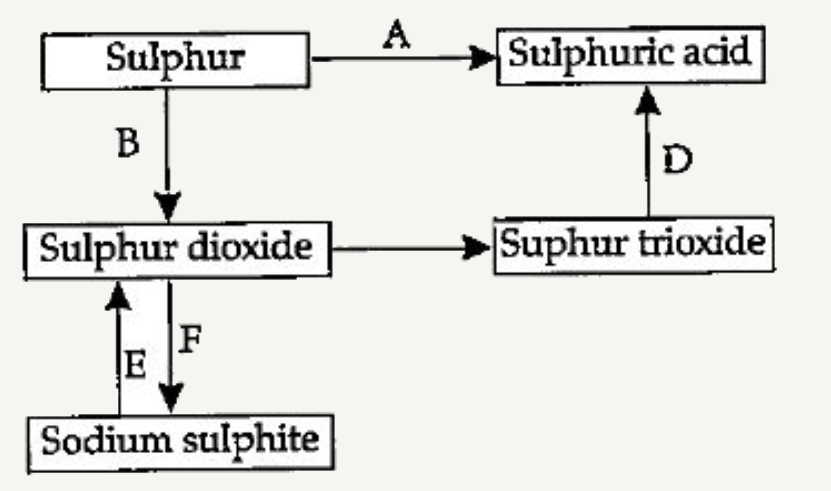Write down the reactions involved in the extraction of Pb. What of the oxidation number of lead in litharge ?
To extract lead (Pb) from its ore, galena (PbS), a series of chemical reactions are involved. The process primarily used for this extraction is called roasting. Below are the steps and reactions involved in the extraction of lead:
1. Identify the Ore:
- The primary ore of lead is galena, which has the chemical formula PbS (lead sulfide).
2. Roasting Process:
- The first step in the extraction is roasting, which involves heating the ore in the presence of excess air (oxygen). This process converts the sulfide ore into an oxide.
3. First Reaction:
- During roasting, lead sulfide (PbS) is oxidized to lead oxide (PbO) and sulfur dioxide (SO₂):
2PbS+3O2→2PbO+2SO2
4. Formation of Lead Sulfate:
- Some of the lead oxide formed can react with sulfur dioxide to form lead sulfate (PbSO₄):
2PbO+SO2+O2→2PbSO4
5. Self-Reduction of Lead Sulfate:
- Lead sulfate can then undergo self-reduction to produce lead (Pb) and regenerate sulfur dioxide:
PbSO4+PbO→2Pb+SO2
6. Final Product:
- The final product of the extraction process is lead metal (Pb).
Oxidation Number of Lead in Litharge:
- Litharge is another name for lead oxide, which has the formula PbO.
- To determine the oxidation number of lead in litharge:
- Oxygen typically has an oxidation state of -2.
- Let the oxidation state of lead be x.
- The overall charge of the compound is neutral (0):
x+(−2)=0⟹x=+2
- Therefore, the oxidation number of lead in litharge (PbO) is +2.
Summary of Reactions:
1. 2PbS+3O2→2PbO+2SO2
2. 2PbO+SO2+O2→2PbSO4
3. PbSO4+PbO→2Pb+SO2
- The primary ore of lead is galena, which has the chemical formula PbS (lead sulfide).
- The first step in the extraction is roasting, which involves heating the ore in the presence of excess air (oxygen). This process converts the sulfide ore into an oxide.
- During roasting, lead sulfide (PbS) is oxidized to lead oxide (PbO) and sulfur dioxide (SO₂):
2PbS+3O2→2PbO+2SO2
- Some of the lead oxide formed can react with sulfur dioxide to form lead sulfate (PbSO₄):
2PbO+SO2+O2→2PbSO4
- Lead sulfate can then undergo self-reduction to produce lead (Pb) and regenerate sulfur dioxide:
PbSO4+PbO→2Pb+SO2
- The final product of the extraction process is lead metal (Pb).
- To determine the oxidation number of lead in litharge:
- Oxygen typically has an oxidation state of -2.
- Let the oxidation state of lead be x.
- The overall charge of the compound is neutral (0):
x+(−2)=0⟹x=+2
- Therefore, the oxidation number of lead in litharge (PbO) is +2.
1. 2PbS+3O2→2PbO+2SO2
2. 2PbO+SO2+O2→2PbSO4
3. PbSO4+PbO→2Pb+SO2
Topper's Solved these Questions
- GENERAL PRINCIPLES AND PROCESS OF ISOLATION OF ELEMENTSBook:CENGAGE CHEMISTRY ENGLISHChapter:GENERAL PRINCIPLES AND PROCESS OF ISOLATION OF ELEMENTSExercise:Archives (Fill In The Blanks)
Explore 4 Videos
- ELECTROCHEMISTRYBook:CENGAGE CHEMISTRY ENGLISHChapter:ELECTROCHEMISTRYExercise:Archieves Subjective
Explore 35 Videos
- GRIGNARD REAGENTS AND ORGANOMETALLIC REAGENTSBook:CENGAGE CHEMISTRY ENGLISHChapter:GRIGNARD REAGENTS AND ORGANOMETALLIC REAGENTSExercise:Exercises Archives (Linked Comprehension)
Explore 1 Video
Similar Questions
Write and explain the reactions involved in the extraction of gold.
View Solution
What is the reaction involved in B?
View SolutionWrite the reaction involved in N2- fixation
View SolutionWrite down the reactions involved during the formation of photochemical smog.
View SolutionWrite the chemical reactions involved in the extraction of metallic silver from argentite.
View SolutionWrite the chemical reactions involved in the extraction of metallic silver from argentite.
View SolutionWrite the reaction involving : Blue solution of Copper sulphate.
View SolutionWrite down the heteroheneous catalyst involved in the polymerisation of ethylene.
View SolutionWrite the chemical equations involved in the extraction of lead from galena by self-reduction process.
View SolutionWrite the chemical equations involved in the extraction of lead from galena by self-reduction process.
View Solution
